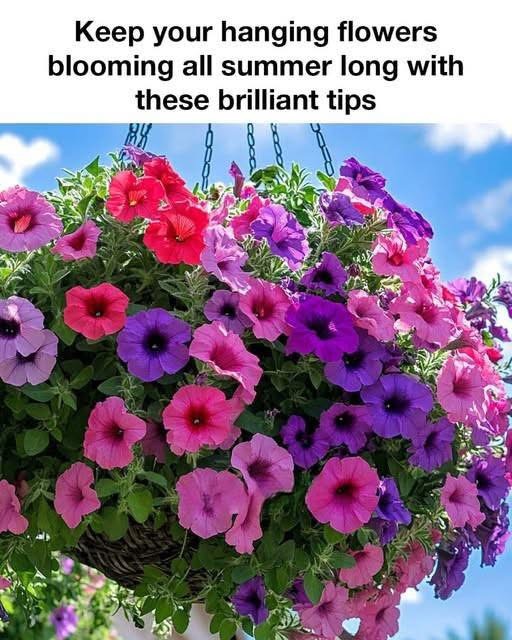Keep your hanging flowers blooming all summer long with
these brilliant tips

Hanging flowers are a delightful way to add a splash of color and elegance to any outdoor space. Whether adorning a porch, balcony, or garden, these suspended floral arrangements bring a touch of nature to eye level, creating a vibrant and inviting atmosphere. During the summer months, hanging flowers can transform a simple outdoor area into a lush, blooming oasis. Their elevated position not only showcases their beauty but also allows for better air circulation, which can be beneficial in warmer climates. To keep these floral displays thriving all summer long, it’s essential to understand their unique needs and provide the right care.
Understanding the Needs of Hanging Flowers
Hanging flowers have specific requirements that differ from those planted in the ground. Due to their elevated position, they are more exposed to the elements, which can lead to faster drying of the soil. Additionally, the confined space of a hanging basket limits the amount of soil and nutrients available to the plants. Understanding these challenges is crucial to maintaining healthy, blooming flowers throughout the summer. Key factors to consider include sunlight exposure, watering frequency, soil composition, and protection from pests and diseases.
Choosing the Right Flower Varieties for Summer Bloom
Selecting the appropriate flower varieties is the first step in ensuring a summer-long display of blooms. Some of the best choices for hanging baskets include petunias, geraniums, fuchsias, and calibrachoas, all of which thrive in warm weather and provide continuous blooms. Consider the climate and sun exposure of your location when choosing flowers. For instance, petunias and geraniums are excellent for sunny spots, while fuchsias prefer partial shade. Mixing different varieties can also create a more dynamic and visually appealing arrangement.
Tip 1: Selecting the Perfect Location for Optimal Sunlight
The placement of your hanging baskets is crucial for the health and growth of your flowers. Most summer-blooming flowers require at least six hours of sunlight per day. However, too much direct sunlight, especially during the hottest part of the day, can cause wilting and stress. Aim to position your baskets where they receive morning sun and afternoon shade, or use a sheer curtain to filter the harshest rays. Regularly assess the light conditions as the sun’s angle changes throughout the season.
Tip 2: Ensuring Proper Drainage to Prevent Root Rot
Proper drainage is essential to prevent water from pooling at the bottom of the basket, which can lead to root rot. Ensure your hanging baskets have adequate drainage holes and consider adding a layer of gravel or broken pottery at the bottom to facilitate water flow. Use a well-draining potting mix specifically designed for containers, which often includes materials like perlite or vermiculite to improve aeration and drainage.
Tip 3: Watering Techniques for Consistent Moisture
Hanging flowers require consistent moisture, especially during the hot summer months. Watering in the early morning or late afternoon helps reduce evaporation and allows the plants to absorb moisture effectively. Use a watering can with a long spout or a hose with a gentle spray attachment to reach the base of the plants without damaging the foliage. Check the soil moisture regularly by sticking your finger about an inch into the soil; if it feels dry, it’s time to water.
Tip 4: Fertilizing Strategies for Continuous Growth
Regular feeding is crucial for maintaining the vigor and bloom production of hanging flowers. Use a balanced, water-soluble fertilizer every two weeks to provide essential nutrients. Alternatively, slow-release fertilizers can be mixed into the soil at the beginning of the season for a steady supply of nutrients. Be cautious not to over-fertilize, as this can lead to excessive foliage growth at the expense of flowers.
Tip 5: Pruning and Deadheading for Enhanced Blooms
Pruning and deadheading are vital practices for encouraging new blooms and maintaining the overall health of your hanging flowers. Regularly remove spent flowers and any dead or yellowing leaves to promote new growth and prevent disease. Pinching back leggy stems can also help maintain a compact and attractive shape. Use clean, sharp scissors or pruning shears to avoid damaging the plants.
Tip 6: Pest and Disease Management for Healthy Plants
Hanging flowers are not immune to pests and diseases, which can quickly spread in the confined space of a basket. Regularly inspect your plants for signs of aphids, spider mites, or fungal infections. Introduce beneficial insects like ladybugs or use organic insecticidal soap to manage pest populations. Ensure good air circulation around the plants to reduce the risk of fungal diseases, and remove any infected plant material promptly.
Tip 7: Using Mulch to Retain Moisture and Regulate Temperature
Applying a layer of mulch on top of the soil in your hanging baskets can help retain moisture and regulate soil temperature. Organic mulches like shredded bark or coconut coir are excellent choices, as they decompose slowly and add nutrients to the soil. Mulch also helps suppress weed growth and can enhance the overall appearance of your hanging baskets.
Tip 8: Rotating Hanging Baskets for Even Growth
To ensure even growth and prevent one side of the basket from becoming overgrown or sunburned, rotate your hanging baskets every few weeks. This simple practice allows all sides of the basket to receive equal sunlight and air exposure, promoting balanced growth and a more symmetrical appearance. Regular rotation also helps you monitor the health of your plants from all angles.
Tip 9: Incorporating Companion Plants for Added Benefits